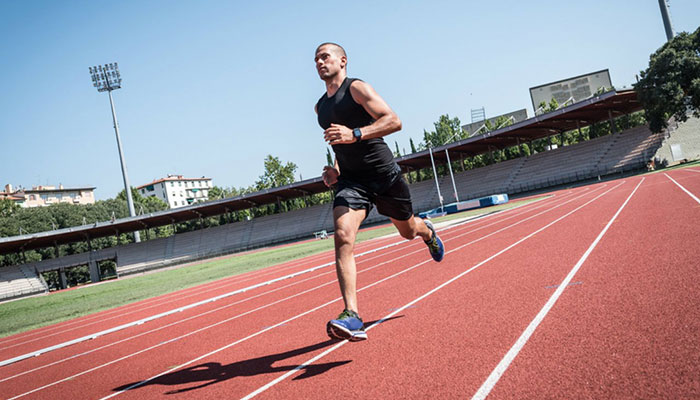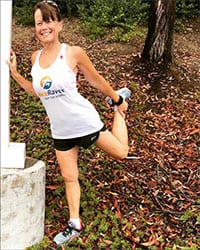
Running is a funny thing (trust me on this).
We humans learn to run early in life and as kids we love to run around, feeling fast and free. Moving fast on our feet is a universal childhood joy after 18 months of rolling over, crawling and toddling.
Those of us who have taken regular running into our adult lives also enjoy running around, feeling fast and free. Until, that is, we enter (and pay for) our first race. Abruptly the joy is tempered by realization that this is an actual competition with winners (a few of us) and participants (most of us).
Whether you desire to win or just finish faster, the need for speed hits you. How do you beat your finish time of that distance? What are the tricks that take us from joyfully finishing 6.1 miles to finishing that distance joyfully faster the next time?
Welcome to training, where crawling and toddling is no longer satisfying. A training program is nothing more than a recipe for your best race, with ingredients, directions and ultimately a finished dish you can be proud of on race day.
What intervals are: the ingredients
One of the most “flavorful” ingredients in a training plan is the interval workout. Running coach and author Jack Daniels defines intervals as “maximizing aerobic power” and “improving bodily function by stressing that function.”
Simply put, intervals are repetitive bursts of faster running with recovery jogs in between. Even some hill work is based on the interval idea: for instance, run up a hill for 90-120 seconds at 10K pace, and use the run back down as the recovery.
Fartlek, a Swedish colloquialism and method of training developed in the late 30s by Cross Country Coach Gosta Holmer which was later used to help lower the record time in the mile, is another name for intervals and serves the same purpose.

What intervals do: the directions
To increase your race speed, you must practice running faster. To continue running fast, you must recover sufficiently to do it again with proper mechanics, or form.
To practice fast running without injury and with good form, we break up fast running into sessions of 90 seconds to 5 minutes — enough time to get to and hold the desired max intensity while still maintaining proper mechanics (form). Pushing yourself in short bursts of speed helps to develop fast-twitch muscles, takes you to an uncomfortable physical state and familiarizes you with how that discomfort feels both physically and mentally.
More importantly, as Daniels states, it improves the bodily function through stress and recovery.
Just as important as the working part of your intervals, the recovery period between each speed section is vital to hitting the goal through the entire workout. Self-discipline is learned when we force ourselves to give as much to the recovery as we do to the work, no matter how great you feel after the first interval. You will need that recovery later, in the 6th or 8th speed section. As former pro runner Lauren Fleshman puts it, “Anyone can work hard. The best have the discipline to recover.”
My most recent half marathon training plan was 8 weeks long. I was coming off a recent race, so the following is not indicative of a new or returning runner’s ideal plan. My overall plan included hill work, long runs, easy or recovery runs, tempo runs and various types of intervals; our focus here will be on the latter.
With the basic idea being periods of running with recovery, the intervals in my plan had many names. Here are my weekly intervals; notice how they changed from Week 1 to Week 8. (Note: each workout includes a 15–20 minute warm-up and cool-down session.)
- Week 1: Stride Workout: 8–10 x 20 seconds starting at 5K pace and progressing to mile race effort with 1-min recovery jog between
- Week 2: Long Hill Intervals: 6–8 times up a moderately sloped hill (4-6% grade) at a medium-to-hard effort lasting 120 to 150 seconds, with the jog back down the hill as recovery
- Week 3: Stride Workout: 10–12 x 25 seconds with 1-min recovery jog between
- Week 4: Cruise Interval Workout: 4–5 x 800 meters with 200m recovery jog between, plus 3 x 200m with 200m recovery jog
- Week 5: Fartlek Workout: 8 x 1 minute at slightly faster than 5K pace with 1-min recovery jog
- Week 6: Cruise Interval Workout: 6–8 x 800 meters with 200m recovery jog between, plus 3 x 200m with 200m recovery jog
- Week 7: Aerobic Capacity Intervals: 3–4 x [3 x 400m with 200m recovery jog] with 400m jog between sets
- Week 8: Stride Workout: 10–12 x 25 seconds with 1-min recovery jog between
As you can see, these intervals did not always progress to longer speed sections from one week to the next. There were weeks that included race-specific workouts, so my interval or speed work days needed to be adjusted. As an added bonus, short bursts such as running sub-5K speed for 25 seconds to one minute reminds us what faster running really feels like; completing a workout like that so close to race day helps during the race when our perceived effort can affect our outcome. In other words, if we know we’ve done it in training, then we’re more likely to be able to do it on race day.
When we let go of our fear of failure, the JOY comes back. Want me to run FAST for 25 seconds? And then jog for a minute? Sure! I can do that and make it a game that leaves me breathless and sweaty and maybe even a bit off balance.
Mindful running moment: Giving yourself permission to take the first couple of intervals a little easy motivates you to push harder as you progress. Running fast while knowing you get to rest for a few minutes between each hard effort feels so manageable.
The need for speed: Share your thoughts
What is your favorite interval or speed play? What are the secret ingredients in your recipe for successfully increasing your speed?
Do you have access to a track? If not, do you prefer your speed workouts in minutes rather than meters?
What kind of speed work makes you joyful?
Feel free to contact me with questions, feedback or to discuss a training plan for your next event. I’m happy to tailor a plan to your goals and fitness level.
See you next month, and be sure watch for my RaceRaves review of the Mesa-Phoenix Marathon coming up on February 9. I’m hoping for a BQ, so wish me luck!
Want to receive Coach Bette’s monthly column in your Inbox? Be sure to subscribe to our newsletter or sign up as a RaceRaves member (it’s free)! And read her most recent column here.
About our columnist:
 Bette Hagerty decided to run a 5K in 1992 after a few months of running around her neighborhood, using her car’s odometer to measure distances. When she found herself among a few hundred people talking about running, she knew she had found her community. Since then she has run several hundred races, from 5K to marathon distance and helped form two running groups.
Bette Hagerty decided to run a 5K in 1992 after a few months of running around her neighborhood, using her car’s odometer to measure distances. When she found herself among a few hundred people talking about running, she knew she had found her community. Since then she has run several hundred races, from 5K to marathon distance and helped form two running groups.
Bette is an RRCA Certified Running Coach and posts weekly Tuesday workouts on instagram as @BetteRunning. Her passions for running and writing have finally run into each other, and she looks forward to sharing her experiences and knowledge. She welcomes your glowing compliments at [email protected].
Other RaceRaves articles you’ll enjoy (trust us!):
9 Quick Picks for 2019
Running Rules of the Road
Runners Choice: Best Marathons in the U.S.
The three Rs of post-workout recovery
Best Bets for Boston Marathon Qualifying Races
Introducing your (smart) 50 States Map
Unconventional Races that dare to be different
And for more helpful articles, check out our blog!
Find this article informative? Please share it, and let others know RaceRaves is the premier online resource to DISCOVER, REVIEW & TRACK all their races and to CONNECT with other runners!
No comments yet